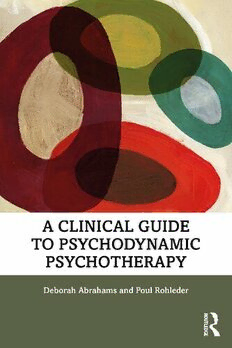
A Clinical Guide to Psychodynamic Psychotherapy PDF
Preview A Clinical Guide to Psychodynamic Psychotherapy
A Clinical Guide to Psychodynamic Psychotherapy A Clinical Guide to Psychodynamic Psychotherapy serves as an accessible and applied introduction to psychodynamic psychotherapy. The book is a resource for psychodynamic psychotherapy that gives helpful and practical guidelines around a range of patient presentations and clinical dilemmas. It focuses on contemporary issues facing psychodynamic psychotherapy practice, including issues around research, neuroscience, mentalising, working with diversity and difference, brief psychotherapy adaptations and the use of social media and technology. The book is underpinned by the psychodynamic competence framework that is implicit in best psychodynamic practice. The book includes a forewordbyProf.PeterFonagythatoutlinestheuniquefeaturesofpsychodynamic psychotherapythatmakeitstillsorelevanttoclinicalpracticetoday. The book will be beneficial for students, trainees and qualified clinicians in psychotherapy, psychology, counselling, psychiatry and other allied professions. Deborah Abrahams is a psychoanalytic psychotherapist and chartered clinical psychologist with over 25 years of clinical experience, including 15 years in the NHS. She is a dynamic interpersonal therapy (DIT) practitioner, supervisor and traineraswellasProgrammeDirectorofDITattheAnnaFreudCentre.Deborah is a senior member of the British Psychotherapy Foundation and has a private psychotherapy practice in North West London offering supervision, psychoanalytic and psychodynamic psychotherapy. Poul Rohleder is a psychoanalytic psychotherapist and chartered clinical psychologist, as well as a dynamic interpersonal therapy practitioner. He has over 15 years’ experience of working in public mental health care systems and in private practice. He is a trustee of the British Psychoanalytic Council and sits on several other professional committees and is currently a senior lecturer at the Department of Psychosocial and Psychoanalytic Studies, University of Essex, UK. A Clinical Guide to Psychodynamic Psychotherapy Deborah Abrahams and Poul Rohleder Firstpublished2021 byRoutledge 2ParkSquare,MiltonPark,Abingdon,OxonOX144RN andbyRoutledge 52VanderbiltAvenue,NewYork,NY10017 RoutledgeisanimprintoftheTaylor&FrancisGroup,aninformabusiness ©2021DeborahAbrahamsandPoulRohleder TherightofDeborahAbrahamsandPoulRohledertobeidentifiedasauthors ofthisworkhasbeenassertedbytheminaccordancewithsections77and78of theCopyright,DesignsandPatentsAct1988. Allrightsreserved.Nopartofthisbookmaybereprintedorreproducedor utilisedinanyformorbyanyelectronic,mechanical,orothermeans,now knownorhereafterinvented,includingphotocopyingandrecording,orinany informationstorageorretrievalsystem,withoutpermissioninwritingfromthe publishers. Trademarknotice:Productorcorporatenamesmaybetrademarksorregistered trademarks,andareusedonlyforidentificationandexplanationwithoutintent toinfringe. BritishLibraryCataloguing-in-PublicationData AcataloguerecordforthisbookisavailablefromtheBritishLibrary LibraryofCongressCataloging-in-PublicationData Acatalogrecordhasbeenrequestedforthisbook ISBN:978-0-815-35265-5(hbk) ISBN:978-0-815-35266-2(pbk) ISBN:978-1-351-13858-1(ebk) TypesetinBaskerville byTaylor&FrancisBooks Contents List of illustrations vii Acknowledgements viii Foreword ix 1 Introduction 1 PART1 Theory and research 11 2 An overview of psychoanalytic theory 13 3 Efficacy and outcome research 43 PART2 Competences 57 4 The setting and the analytic frame 59 5 Assessment and formulation 88 6 Anxiety and defences 127 7 Mentalising 149 8 Unconscious communications 167 9 Transference and countertransference 183 10 Endings 207 vi Contents PART3 Adaptations and practicalities 219 11 Brief applications of psychodynamic work 221 12 Challenging situations and clinical dilemmas 239 13 Working with difference 256 14 Technology and social media 273 Appendix 1: Specimen terms and conditions 294 Appendix 2: Specimen referral/pre-assessment questionnaire 296 Appendix 3: Specimen end of therapy report 299 Appendix 4: Specimen social media contract 301 Appendix 5: Specimen privacy notice for website 303 References 305 Index 319 Illustrations Figures 1.1 The core competences for psychodynamic psychotherapy 4 2.1 Freud’s model of the mind 19 3.1 A diagrammatic representation of a randomised control trial 45 6.1 A diagrammatic representation of Freud’s model of anxiety and defence 129 6.2 Adapted from Malan’s triangle of conflict 144 8.1 Therapist and patient position triangles 181 9.1 Adapted from the Triangle of Person or Insight 193 11.1 Two examples of an Interpersonal Affective Focus for DIT 230 14.1 Updated Maslow’s (1943) hierarchy of needs 273 Tables 3.1 Comparisons of meta-analysis studies on treatment effectiveness 46 6.1 Different types of defences 130 Acknowledgements The authors would liketo dedicate the book to our patients, from whom we have learned so much. We would like to thank our clinical supervisors for their wise guidance over the years. We are grateful to our colleagues with whom we have worked closely in the Camden & Islington NHS Foundation Trust, Anna Freud Centre,TavistockClinicandpeersupervisiongroupsattheBritishPsychotherapy Foundation. We are especially appreciative of the support and endorsements of Peter Fonagy, Alessandra Lemma, Bob Hinshelwood and Maxine Dennis. Foreword When I pick up this excellent introduction by Abrahams and Rohleder, I wonder what the secret ingredient might be that ensures the survival of the ideas and practices stated with brilliant clarity in this book. In principle, no scientific theory or clinical practice that is 125 years old has any right to be describedasrelevanttocurrentpractice.So,whathashelpedpsychoanalysisandits offspring,psychodynamicpsychotherapy,tosurvivealltheseyears.InthisForeword, Iwouldliketoadvanceafewsuggestionsabouttheuniquefeaturesoftheapproach whichareallexceptionallywellexemplifiedbyAbrahamsandRohleder’sbook. First, the idea that the mind is capable of generating mental disorder, the so-called principle of psychological causation, revolutionised psychiatry in the 19th century. The term ‘dynamic’ was used in the late nineteenth century by Leibniz, Herbart, Fechner, and Hughlings-Jackson to contrast with the word ‘static’ (Gabbard, 2000). As such, the word served to highlight the distinction between a psychological and a fixed organic neurological impairment model of mental disorder. Evidently, the approach continues to benefit from the flexibility this bridging of the mind-body divide generates. More recently, ‘dynamic’ has come to be contrasted with descriptive phenomenological psy- chiatry that has focused on categorising mental disorders in circumscribed ways, rather than emphasising the way mental processes (thinking, feeling, wishing, believing, desiring) interact to generate problems of subjective experience and behaviour. Psychodynamic Theory, as outlined in the first chapters of this book, is focused on understanding how we can meaningfully conceive of mental disorders as specific organisations of an individual's con- scious or unconscious beliefs, thoughts and feelings. The rich case studies presented throughout illuminate the subtleties of this process and how the psychodynamic clinician, charged with the task of investigating the specific ideas and constructions, is able to elegantly explain a person’s suffering. Second,psychodynamicpsychotherapyisuniqueindescribinghowpsychological causation extends tothe non-conscious part of themind. Nagel, Wollheim,Hopkins and otherphilosophersofthemind(Hopkins,1992;Nagel,1959;Wollheim,1995)have allpointedtotheassumptionofunconsciousmentalisationasakeydiscoverywithin the psychoanalytic model. Implicitly or explicitly, psychodynamic models assume that non-conscious narrative-like experiences, analogous to conscious fantasies,
